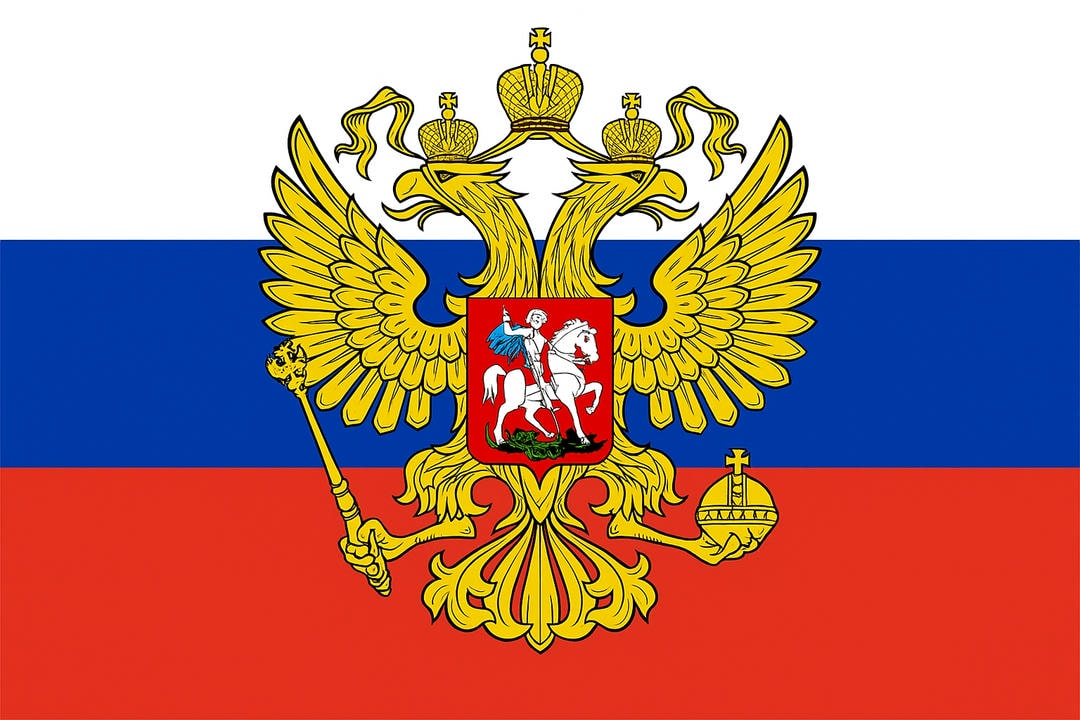Russian cuisine offers a fascinating glimpse into the nation’s history, climate, and cultural practices. At its core, staple foods reflect a resilience to harsh winters and a celebration of communal dining. Bread, grains, and root vegetables form the backbone of many traditional meals, often accompanied by fermented foods that preserve summer’s bounty. As these foods nourish both body and spirit, they hold stories of survival and hospitality, inviting exploration into their enduring significance.
Introduction
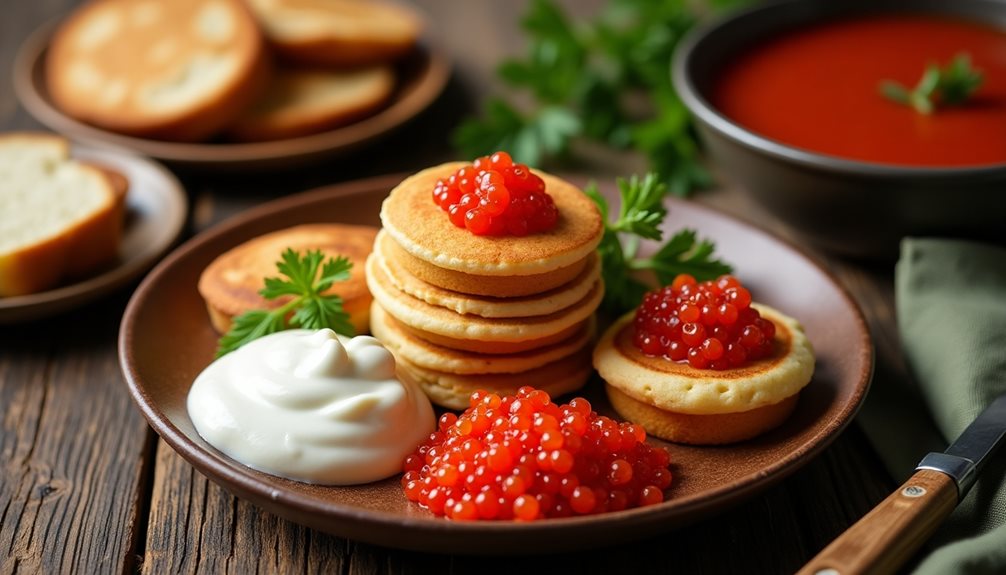
Russian cuisine is defined by hearty staples that reflect the country’s diverse geography and historical influences. Traditional foods are celebrated for their nutritional value, shaped by a climate that demands sustenance and warmth.
Meals often center around family gatherings, featuring dishes made with seasonal ingredients. While culinary customs evolve over generations, staples like bread, potatoes, and cabbage remain integral to daily life. These abundant and adaptable ingredients embody the resilience of Russian gastronomy, uniting people through shared meals and traditions.
Traditional Russian foods are known for their rich flavors and comforting qualities, offering various health benefits. Staples such as buckwheat and fermented vegetables provide essential nutrients, contributing to robust health and emphasizing food sustainability during harsh winters. As modern cooking evolves, there is a renewed appreciation for these age-old ingredients, blending them with contemporary techniques to create a diverse and nutritionally balanced diet.
Russia’s vast geography—from the icy Siberian plains to the fertile southern steppes—dictates regional ingredient availability. The harsh winters necessitate preserved foods, while short summers yield bountiful produce. This geographical diversity fosters a cuisine rich in adaptability and innovation, with dishes reflecting the environment and utilizing local resources.
Religious practices and fasting periods have significantly influenced Russian food preparation. Fasting dictated culinary rhythms, leading to diverse dishes made from grains and vegetables when meat and dairy were restricted. In contrast, holiday feasts celebrate abundance with symbolic foods marking significant events. This interplay of austerity and festivity reveals the intricate balance that continues to shape dietary choices in Russian society.
Bread Varieties
Throughout Russian history, bread has transcended mere sustenance to become a cultural cornerstone rich in tradition. Rye bread, celebrated for its robust flavor and health benefits, has been a staple of Russian diets since medieval times. Wheat bread, with its nutritional value, complements everyday meals and symbolizes prosperity and hospitality.
Distinct from these breads are pirozhki, small pastries filled with various ingredients that showcase the regional diversity of Russian cuisine. Rye bread embodies centuries-old baking techniques, offering a range of flavors from tangy and robust to sweet and mild, reflecting local variations. In cities like Moscow and St. Petersburg, unique recipes contribute to a rich tapestry of tastes.
The enduring presence of bread in Russian households symbolizes the resilience and adaptability of the people, serving as a profound reminder of sustenance and freedom. Wheat bread has gained popularity due to its fiber, vitamins, and minerals, often paired with soups and salads, illustrating its versatility in the diet.
Pirozhki have significant cultural and historical importance, dating back to the 12th century. These pastries, whether baked or fried, come in various forms with fillings like meat, cabbage, or mushrooms. Modern interpretations feature healthier options such as spinach or quinoa, aligning with contemporary dietary preferences. The evolution of pirozhki reflects a dynamic interplay between tradition and innovation, allowing for personal culinary expression through experimentation.
Grains and Cereals
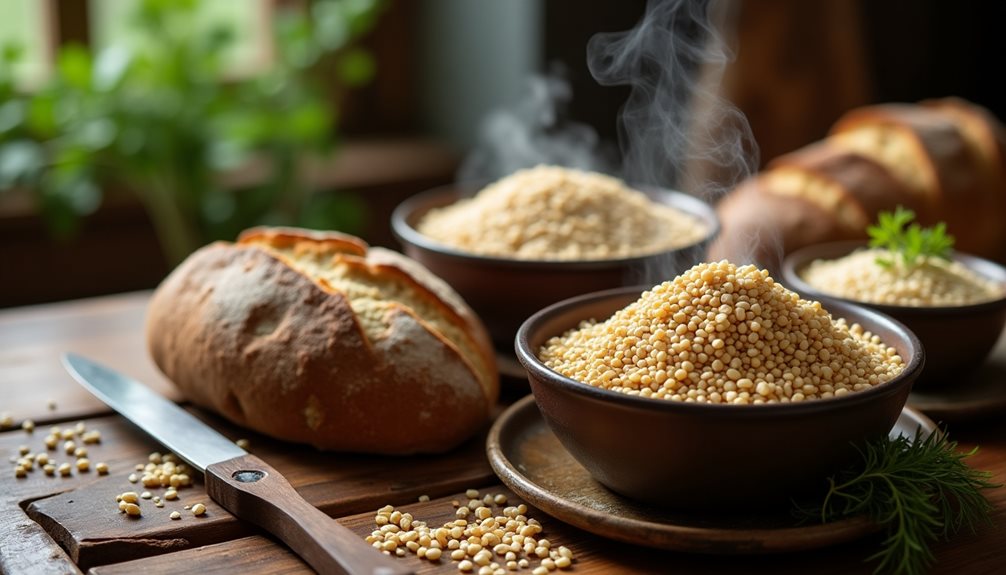
Grains and cereals play a vital role in Russian cuisine, with kasha being a quintessential example rooted in ancient Slavic traditions. This dish encompasses various grains, particularly buckwheat, millet, and oats, which serve as staple components in meals and provide significant health benefits due to their high fiber content and essential nutrients. Historically, the preparation of kasha has evolved from simple boiling methods to more intricate cooking techniques that enhance its rich flavors. Buckwheat, known for its nutty taste, pairs well with meats, while the mild flavor of millet complements vegetables. Oats are often enjoyed at breakfast for their creamy texture.
Kasha’s cultural significance lies in its adaptability, making it a staple in both festive and everyday meals. This versatility reflects Russia’s enduring culinary heritage and invites endless exploration of flavors. Although traditional Russian cuisine heavily relies on ingredients like potatoes and refined grains, there is a growing trend toward incorporating whole grains into classic dishes, mirroring a global shift toward healthier eating habits. The benefits of whole grains are increasingly recognized, with nutrition education initiatives promoting healthier cooking techniques. For instance, buckwheat is now being used instead of refined grains in blini, and barley in cabbage rolls, providing nutrient-rich alternatives to traditional recipes that honor their heritage while maximizing the health potential of whole grains.
Soups and Stews
Soup holds a vital place in Russian cuisine, serving as both a staple food and a cultural symbol that reflects the nation’s rich culinary heritage. Renowned varieties such as borscht, shchi, and okroshka not only nourish but also bring people together, highlighting the communal aspect of dining.
Borscht, the iconic beetroot soup, is celebrated for its vibrant color, nutritional benefits, and deep-rooted cultural significance. It has evolved into various regional adaptations, each showcasing local flavors while fostering a sense of community. Similarly, shchi, a traditional cabbage soup with a history dating back to the 9th century, embodies resilience and adaptability. Its numerous variations reflect regional ingredients and preparation methods, making it a comforting staple rich in fiber and vitamins. Meanwhile, okroshka, a refreshing cold soup made with kvass, is perfect for summer months. Its light and hydrating qualities highlight the culinary creativity found in Russian cuisine, adapting to seasonal changes and local ingredients.
The Richness of Russian Meat Dishes
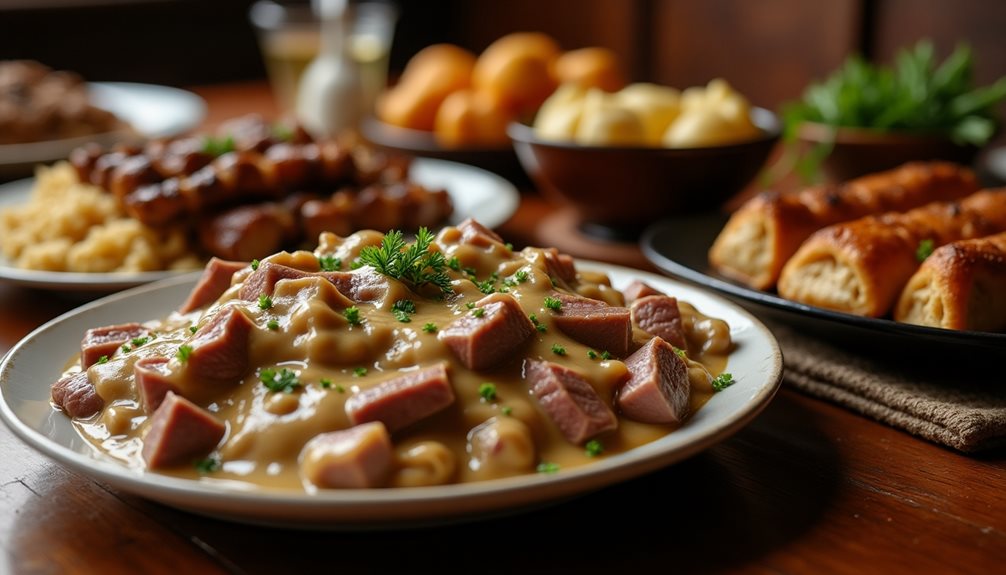
Russian cuisine is celebrated for its hearty meat dishes, with Beef Stroganoff and Shashlik standing out as quintessential examples that embody the country’s culinary heritage.
Beef Stroganoff: A Classic Favorite
Beef Stroganoff traces its origins to the 19th century, reflecting the opulence of its era. This dish features tender cuts of beef, such as sirloin or tenderloin, which are quickly sautéed to enhance their flavor. Over the years, cooking methods have evolved, with healthier techniques like grilling becoming popular alternatives to frying.
The creamy sauce, traditionally made with sour cream, has seen variations that include yogurt or plant-based alternatives, catering to modern dietary preferences. Beef Stroganoff is versatile in its accompaniments, often served over pasta, rice, or potatoes, allowing it to adapt while retaining its core essence. The tradition of communal dining is emphasized in its presentation, highlighting a culture that values shared meals and culinary exploration.
Shashlik: A Communal Tradition
In contrast to the richness of Beef Stroganoff, Shashlik offers a different yet equally cherished taste experience. Originating from the Caucasus region, shashlik represents the communal tradition of grilling skewered meats. This practice has gained widespread popularity throughout Russia and showcases regional variations in marinades and preparation techniques.
From vinegar and onion in southern regions to yogurt-based mixes in the north, these marinades highlight local flavors and preferences. Grilling techniques often involve open flames, which enhance the natural juices of the meat, resulting in succulent bites. Shashlik can be enjoyed as simple street food or presented elegantly at gatherings, embodying the joyful diversity of Russian culinary culture.
In summary, both Beef Stroganoff and Shashlik reflect the richness and variety of Russian cuisine, each contributing its unique flavor and tradition to the culinary landscape.
Pancakes and Crepes
Pancakes and crepes hold a significant place in Russian cuisine, with blini and syrniki being two prominent examples that have evolved over centuries.
Blini
Blini, a cherished culinary staple in Russian cuisine, have evolved over centuries from simple thin pancakes to versatile delights with a variety of fillings and toppings.
Today, blini variations include buckwheat, whole wheat, and gluten-free options, making them accessible to diverse dietary preferences.
Blini cooking involves mastering the art of achieving lightness and golden hues.
Traditionally served with sour cream and caviar, modern blini toppings include smoked salmon, fresh fruit, and yogurt.
Their adaptability allows for creative blini serving, inviting culinary experimentation and cultural exploration.
Syrniki
As the exploration of Russian culinary traditions continues from the versatile blini, attention turns to syrniki, another beloved staple.
Originating in the Slavic regions, syrniki are cottage cheese pancakes that boast numerous syrniki variations, reflecting regional tastes and preferences. Known for their health benefits, these pancakes are rich in protein and calcium.
Traditional toppings, such as sour cream, honey, or berry preserves, enhance their flavor. Cooking techniques have evolved, with frying remaining the most popular.
Syrniki’s adaptability allows for creative serving suggestions, presenting opportunities for culinary experimentation. Their enduring popularity speaks to their role in Russian gastronomic heritage.
Vegetables and Salads in Russian Cuisine
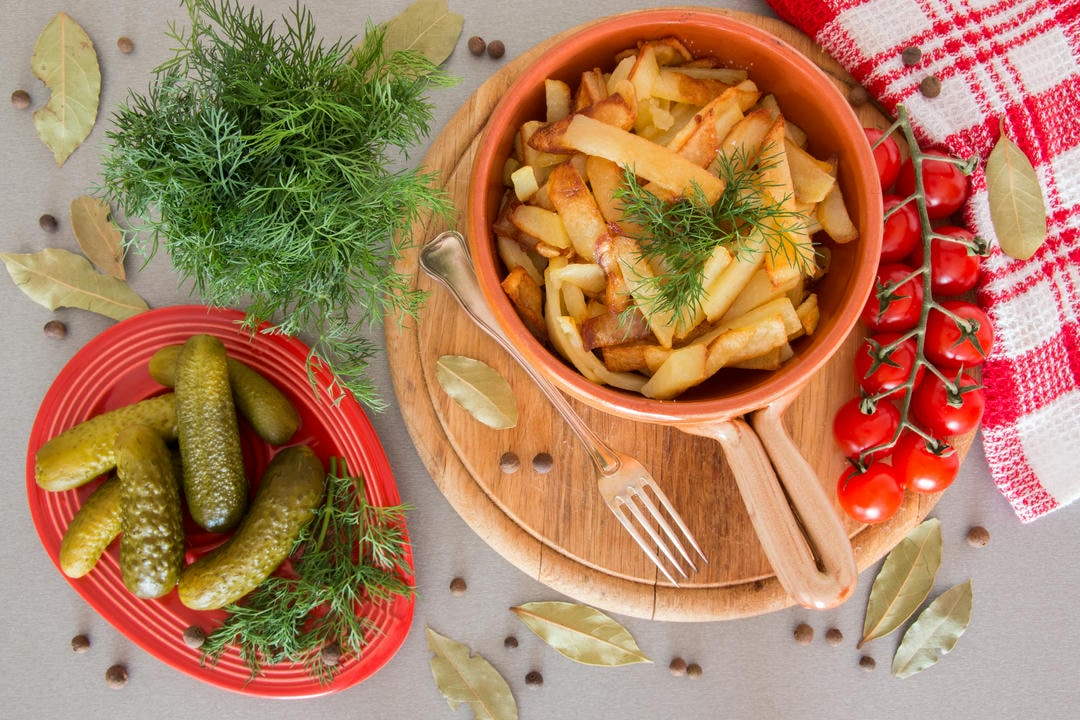
Vegetables and salads are fundamental to Russian cuisine, with Olivier Salad being a festive staple that showcases both tradition and evolving dietary preferences. Over time, this dish has seen healthier ingredient substitutions, reflecting changing tastes.
Historically, pickled vegetables have been essential in traditional Russian meals, preserving the harvest and providing the health benefits of fermentation. As culinary practices evolve, the importance of vegetables in Russian gastronomy remains prominent.
Olivier Salad
Olivier Salad is a beloved fixture at Russian celebrations, tracing its origins back to the 19th century. This dish embodies communal joy and has adapted to modern health trends.
While traditionally rich and creamy, contemporary versions feature leaner proteins and a variety of vegetables. Alternative dressings, such as yogurt or olive oil-based emulsions, have replaced heavier mayonnaise, allowing Olivier Salad to connect historical culinary traditions with modern dietary preferences.
Pickled Vegetables
The evolution of Olivier Salad mirrors a broader trend in Russian cuisine where tradition meets modernity, particularly evident in the enduring practice of pickling vegetables.
Originally a vital preservation method for seasonal produce during harsh winters, pickling techniques have evolved while retaining their cultural significance. The health benefits of fermented foods are increasingly recognized for their probiotics that support digestive health.
As culinary preferences shift, pickled vegetables continue to enhance Russian meals, bridging the past and present with diverse flavors and nutritional advantages.
Modern Adaptations of Traditional Dishes
In recent years, traditional Russian recipes have transformed significantly to align with global health trends, reflecting a broader shift towards more conscious eating habits. This evolution is marked by the increasing popularity of vegetarian and vegan adaptations of classic dishes, such as borscht and pelmeni, catering to a growing demographic seeking plant-based options.
Historically rooted in hearty, meat-centric cuisine, Russian gastronomy now embraces a diverse culinary landscape that bridges past traditions with contemporary dietary preferences. Modern cooking techniques prioritize the preservation of nutrients and flavor, while nutritional education initiatives led by chefs and food enthusiasts are transforming traditional dishes into health-conscious alternatives.
Health-Conscious Adaptations
As the global appetite for plant-based diets grows, classic Russian dishes are undergoing innovative transformations. For instance:
- Vegetarian Borscht: Replacing beef with beets and carrots.
- Vegan Pirozhki: Swapping traditional fillings for mushrooms and cabbage.
- Plant-Based Blini: Utilizing almond or oat milk instead of dairy.
- Nutritious Kasha: Once a staple, now caters to those seeking healthier grain options.
- Alternative Shchi: A twist on cabbage soup that omits meat entirely.
These adaptations reflect a cultural shift towards healthier, cruelty-free eating, honoring tradition while embracing modern dietary freedoms.
A Culinary Renaissance
Throughout history, Russian cuisine has showcased a rich variety of staples that reflect both cultural depth and regional diversity. From the hearty warmth of borscht to the simplicity of buckwheat kasha, these dishes offer insights into Russia’s culinary past while aligning with contemporary health trends emphasizing nutrition and balance.
The dynamic interplay between traditional flavors—shaped by centuries of cultural influences—and modern health consciousness allows individuals to enjoy a culinary experience rooted in both heritage and innovation. Time-honored culinary techniques preserve essential nutrients, while seasonal ingredients enhance the overall quality of meals.
Conclusion
As Russian cuisine continues to adapt, it remains a testament to the country’s ability to honor its traditions while embracing modernity. This ongoing evolution not only reflects a commitment to well-being but also highlights the potential for culinary freedom that satisfies both nostalgia and contemporary dietary preferences.



